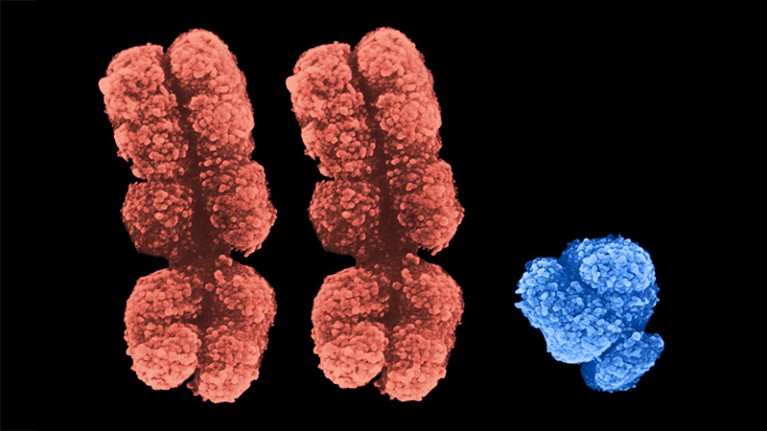
[ad_1]

Microscope image of two X and one Y chromosome, as found in a sex-development condition called Klinefelter syndrome.Credit: Biophoto Associates/Science Photo Library
Researchers have identified some of the earliest known cases of sex-chromosome syndromes — in five ancient humans.
“It’s quite interesting to think that these people existed throughout human history and how they seem to have been part of their societies,” says Kyriaki Anastasiadou, who studies ancient genomics at the Francis Crick Institute in London and is a co-author of the study, which was published on 11 January in Communications Biology1.
People with extra or missing chromosomes often have differences in appearance and behaviour compared with others in the population. By identifying individuals who had these genetic syndromes, the researchers’ could illuminate how past societies viewed and treated people with differences.
Number crunching
Through sequencing ancient DNA, researchers have previously found2 ancient people with an atypical number of chromosomes, including an infant with Down syndrome — caused by an extra copy of chromosome 21 — who lived around 5,000 years ago.
Anastasiadou and her colleagues have now discovered the first prehistoric person known to have had Turner syndrome, which occurs in females and is characterized by having only one complete copy of the X chromosome, instead of the two copies usually found in females (males have one X and one Y). The person lived in Somerset, UK, roughly 2,500 years ago, during the Iron Age. People with Turner syndrome tend to be shorter than average and experience fertility problems.
The other people the researchers identified with sex-chromosome syndromes were male. Among them was the earliest known person to have an extra Y chromosome, known as Jacob’s syndrome, which is linked to being taller than average. The man lived around 1,100 years ago, during the Early Medieval Period. The team also found three ancient males from different points in time who had an extra X chromosome, a condition known as Klinefelter syndrome, which is linked to growing taller than average and having broader hips and larger breasts.
The authors analysed DNA samples extracted from teeth, as well as skull, jaw and ear bones. For each person, they used a computational tool to calculate the number of DNA fragments that were derived from the X and Y sex chromosomes and compared them with the amount of DNA fragments derived from non-sex chromosomes. From this, they deduced the presence and ratio of X and Y chromosomes in each person. The team has made the tool available online.
Burial clues
There is no evidence that the people were treated differently from those without the syndromes, says Anastasiadou. “There didn’t seem to be anything different about how they died or how they were buried at first glance,” she says.
“This is a major breakthrough and provides us with a window into the perception and treatment of difference in ancient societies,” says anthropologist Bettina Arnold at the University of Wisconsin–Milwaukee. The approach could shed light on what it means to be human, she says.
“The more studies like this are done, the better we can explore how past societies viewed sex and gender, or in the case of certain [genetic syndromes], how disability may have been understood in the past,” says archaeologist Ulla Moilanen at the University of Turku in Finland.
Source link




